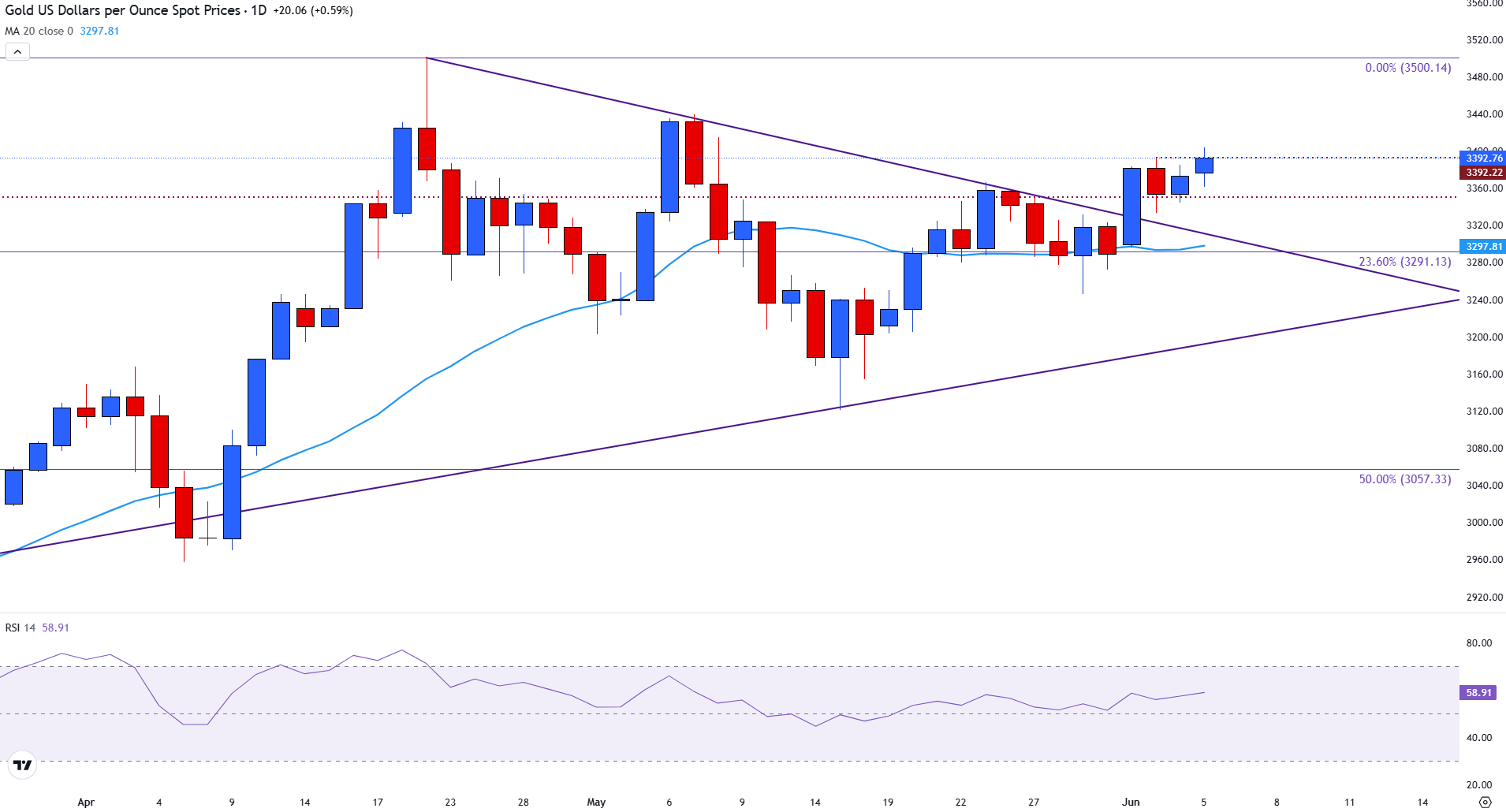Gold extends gains ahead of ECB rate decision, US Jobless Claims, and trade talks
- Gold edges higher as persistent trade tensions and the uncertain global economic outlook support safe-haven assets.
- ECB rate decision, Trump’s meeting with German Chancellor, and US employment data are in focus on Thursday.
- Gold retests $3,400 as bulls eye April’s all-time high at $3,500.
Gold (XAU/USD) extends its upward move during the European session on Thursday, with markets focusing on the European Central Bank (ECB) decision, US employment data, and developments surrounding trade talks ahead of US President Donald Trump’s meeting with German Chancellor Friedrich Mertz.
The precious metal is trading near $3,400 at the time of writing. A break of this critical psychological resistance level could open the door for a potential retest of April’s all-time high at $3,500.
ECB prepares for a 25 bps interest rate cut
The European Central Bank (ECB) is expected to announce a 25 basis points (bps) interest rate cut, while the weekly US Initial Jobless Claims figures will provide additional insight into the health of the labor market ahead of Friday’s Nonfarm Payrolls (NFP) report.
Later in the day, German Chancellor Friedrich Mertz will be meeting US President Donald Trump at the White House to discuss current geopolitical issues.
Gold daily digest: ECB rate decision, trade talks, and US employment data ahead
- Weekly US Initial Jobless Claims are expected to fall to 235K, from 240K reported last Thursday. A reading above analysts' forecasts could highlight further softening in the health of the US labour market.
- Friday’s NFP figures are expected to show that 130,000 new jobs were added to the US economy in May, down from 177,000 in April.
- Meanwhile, the US Unemployment Rate is expected to remain at 4.2% in May, reflecting a resilient US labour market.
- The weak ADP employment data released on Wednesday showed that just 37K jobs were added to the US private sector in May.
- Market sentiment remains cautious due to a series of developments, including the US tariff increase on steel and aluminum from 25% to 50%, which took effect on Wednesday. The growing tariff threats and escalating trade tensions have posed a significant risk to risk assets, while a weaker US Dollar has been supportive of Gold prices.
- On Thursday, Reuters reported that Canadian Prime Minister called US tariffs “illegal” while Mexico and the European Union expressed similar frustration.
- On Wednesday, Mexican President Claudia Sheinbaum called the new tariffs "unjust, unsustainable, and without legal grounds," warning that if a deal is not reached, Mexico will be forced to respond with retaliatory measures.
- Canada and the EU have also threatened to retaliate if no progress is made in trade talks this week.
Gold technical analysis: Bulls drive prices to psychological resistance at $3,400
Gold (XAU/USD) is exhibiting signs of renewed bullish momentum after breaking out of a well-defined symmetrical triangle on the daily chart.
The breakout above the upper trendline and the key horizontal resistance at $3,392 suggests growing bullish sentiment, reinforced by a rising Relative Strength Index (RSI) above 59.
The sustained close above the 20-day Simple Moving Average (SMA) at $3,298 could pave the way for a move toward the psychological resistance at $3,500, marking a retest of the prior swing high.
However, a move below the $3,350 psychological level and below the 20-day SMA could initiate bearish momentum toward the $3,291, the 23.6% Fibonacci retracement level of the January-April rally.
A daily close below this zone would expose the lower boundary of the triangle near $3,240, and potentially trigger a deeper correction toward the 50% Fibonacci retracement level around $3,057.
Gold daily chart

Gold FAQs
Gold has played a key role in human’s history as it has been widely used as a store of value and medium of exchange. Currently, apart from its shine and usage for jewelry, the precious metal is widely seen as a safe-haven asset, meaning that it is considered a good investment during turbulent times. Gold is also widely seen as a hedge against inflation and against depreciating currencies as it doesn’t rely on any specific issuer or government.
Central banks are the biggest Gold holders. In their aim to support their currencies in turbulent times, central banks tend to diversify their reserves and buy Gold to improve the perceived strength of the economy and the currency. High Gold reserves can be a source of trust for a country’s solvency. Central banks added 1,136 tonnes of Gold worth around $70 billion to their reserves in 2022, according to data from the World Gold Council. This is the highest yearly purchase since records began. Central banks from emerging economies such as China, India and Turkey are quickly increasing their Gold reserves.
Gold has an inverse correlation with the US Dollar and US Treasuries, which are both major reserve and safe-haven assets. When the Dollar depreciates, Gold tends to rise, enabling investors and central banks to diversify their assets in turbulent times. Gold is also inversely correlated with risk assets. A rally in the stock market tends to weaken Gold price, while sell-offs in riskier markets tend to favor the precious metal.
The price can move due to a wide range of factors. Geopolitical instability or fears of a deep recession can quickly make Gold price escalate due to its safe-haven status. As a yield-less asset, Gold tends to rise with lower interest rates, while higher cost of money usually weighs down on the yellow metal. Still, most moves depend on how the US Dollar (USD) behaves as the asset is priced in dollars (XAU/USD). A strong Dollar tends to keep the price of Gold controlled, whereas a weaker Dollar is likely to push Gold prices up.

